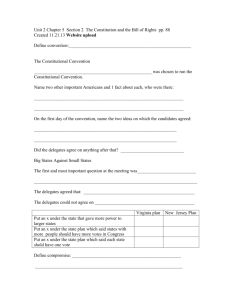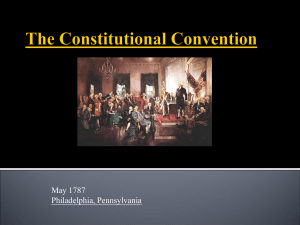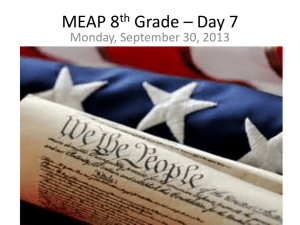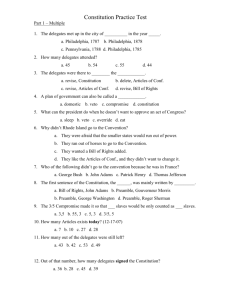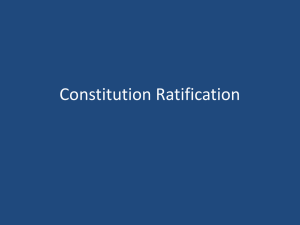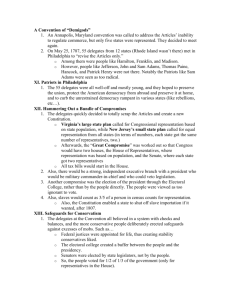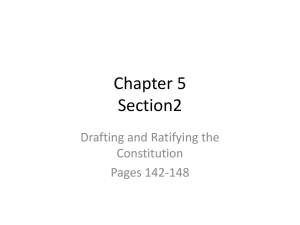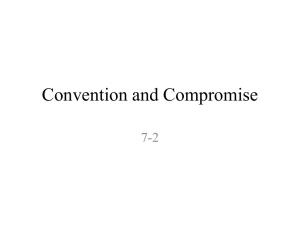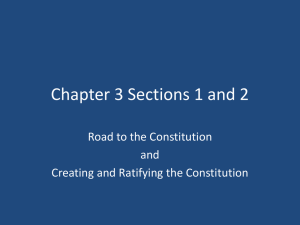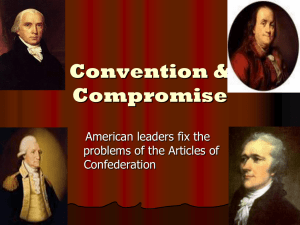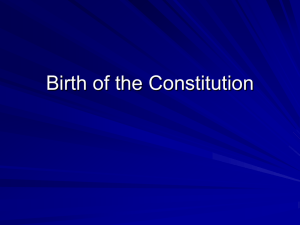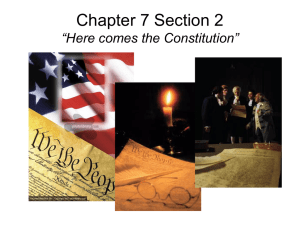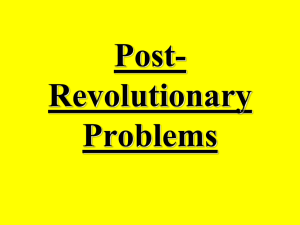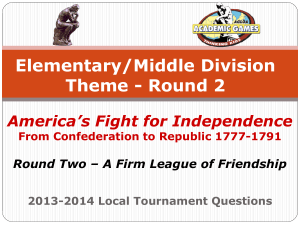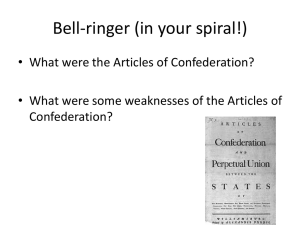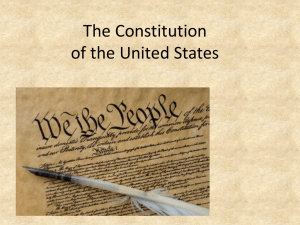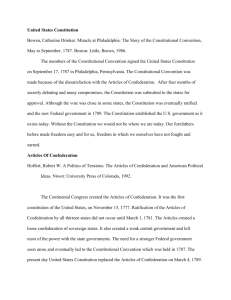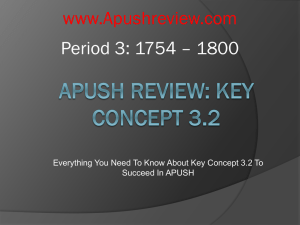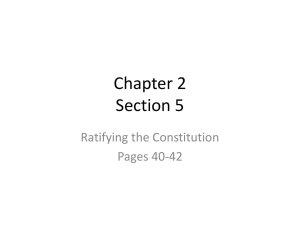The New Government is Weak
advertisement
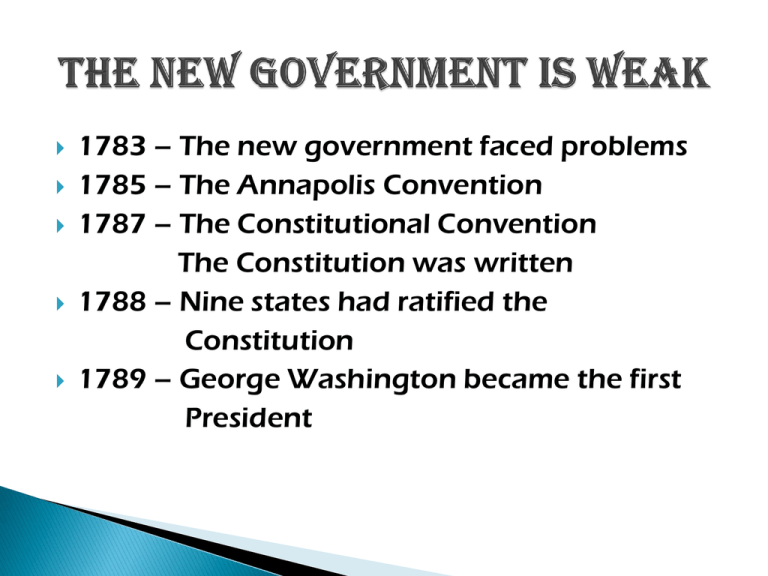
1783 – The new government faced problems 1785 – The Annapolis Convention 1787 – The Constitutional Convention The Constitution was written 1788 – Nine states had ratified the Constitution 1789 – George Washington became the first President In 1783 the Peace of Paris was signed America won the war and it’s independence No longer under British rule. America had to make a new government. In 1781 the states agreed to a central government Adopted the Articles of Confederation During the war states worked together to fight the British After winning their independence the states felt differently. No state was willing to give up the right to govern themselves. Coming up with a plan of government that all would be happy with was just one of their problems. There was a problem with land claims in the western part of the nation. Overlapping land claims made it difficult for settlers to get help fighting Indians or Spaniards. A workable system of land ownership was devised. Plans were made to permit new states to be formed. English merchants became wealthy and powerful by trading with the colonies. United States was not considered an equal trading partner. After war, England closed its ports to American shippers. English merchants continued to send their goods to the United States and could undersell American manufacturers Americans had to find new trading partners to survive. The Spanish controlled Florida, New Orleans, and land west of the Mississippi River Had little respect for new nation. Americans were unwelcome in the southern region. Spain would not let them ship from New Orleans. Western settlers had to travel overland. a. difficult route b. slow and costly. United States too weak to force the Spanish to change their policy. Without respect of Spain, England, or even France, the young country was not doing well. It became obvious something needed to be done. Government of the 13 states was weak under Articles of Confederation. 9 of 13 state each had to give approval before Congress could do anything. No power to levy taxes or place duties on imported items. With less money coming in the debt was increasing. States were printing their own money. Sometimes wouldn’t be accepted by the state or other states. Congress lacked authority to regulate trade between states. States began to treat each other as separate countries. a. used tariffs b. caused reduction in interstate trade. This encouraged British to send more products. British goods were bought instead of American goods. There were no United States courts. State courts could not settle disputes between states. Country was out of control and needed change!!!! Everyone did not agree with the Articles of Confederation. Businessmen, merchants, shippers, manufacturers, and bankers wanted a strong government Unable to protect themselves from unfair laws that Great Britain passed. Maryland and Virginia were having disagreement over commercial rights on the Potomac River. James Madison suggested a convention be held in Annapolis, MD All states were invited. Only 5 sent representatives. Not even Maryland sent a representative. Not much was accomplished Farmers were upset by low farm prices and high state taxes. Leader Daniel Shay lead a rebellion. a. closed courthouses b. almost captured a store house of weapons Rebellion happened in Massachusetts in winter of 1786. Delegates met in May of 1787 at the State House in Philadelphia. All states attended but Rhode Island. 55 of the most respected Americans were present. Philadelphia State House It was decided all sessions were to be held in secret. George Washington was chosen to lead the convention. It was a wise choice the difficult convention needed a man of his ability and leadership. The main purpose of the convention was to adjust the Articles of Confederation. One new plan from Edmund Randolph of Virginia included a. stronger central government b. greater control by the larger states c. became known as the “large state plan” The Large State Plan (VIRGINIA PLAN) The plan was to establish a congress to a. make laws b. to enforce the laws c. guarantee justice under the law The Congress was to be divided into two branches a. Legislators in the lower house would be elected by the people. b. Upper house would be chosen by the members of the lower house. The Small State Plan (NEW JERSEY PLAN) William Patterson of New Jersey presented an alternative plan. a. Like the one already in existence b. Each state had equal vote. c. States have more control of the government. The debate became very heated and tempers were short. Delegates were ready to quit. Ben Franklin calmed everyone down . George Washington kept a firm control and encouraged the delegates to be both cooperative and willing to compromise. A special committee was formed to try to work out a compromise. The Compromise Committee presented its report to the convention. a. Legislative branch made up of two houses 1. The House of Representatives 2. Senate b. The house of Representatives would be made up according to the population. The state with more people had more representative c. Senate have two representatives from each state d. As law makers each branch would be equal except that all money bills would be started in the House. e. Plan called the “Great Compromise” was accepted on July 16, 1787. Southern States wanted slaves to be represented in the population count.(3/5 COMPROMISE) President elected as the head of the executive branch ◦ He would serve 4 year term Supreme Court highest court Trade was a concern to all states. a. Congress to regulate trade between states and foreign countries. 1. Duties would no be allowed between states 2. Taxes would be permitted between US and foreign countries. Key issue for southern states was runaway slaves a. slaves that ran away should be returned to their owners. Compromises did not please everyone Delegates signed the Constitution with the hope that states would approve it. Need to decide if the Constitution should be cornerstone of new government. Nine of the thirteen state ratified it Federalists vs. Anti-Federalists Those who supported Constitution – Federalists Those who opposed Constitution – Anti-Federalists…they had concerns about: a. gave to much power to central government b. increase in taxes c. did not provide protection for the protection of personal freedom d. did not clearly explain the rights of citizens Federalists Take Action The Federalists – led by Alexander Hamilton, James Madison and John Jay fought hard for its ratification. Published a series of essays called Federalists The papers were circulated throughout the states Papers Constitution is Ratified The first state to ratify was Delaware. In June of 1788 the United States officially had a new government when 8 more states ratified Without the support of Virginia and New York the government would be at a disadvantage. On June 25, 1788 Virginia ratifies On July 26, 1788 New York ratifies George Washington was elected President John Adams was Vice-President The Cabinet was formed Four departments were created to help the President. a. Secretary of State b. Secretary of Treasury c. Secretary of War d. Attorney General Some states did not like the Constitution Suggested provisions be added for personal freedoms In 1791 10 amendments were added to the constitution This became know as the Bill of Rights

